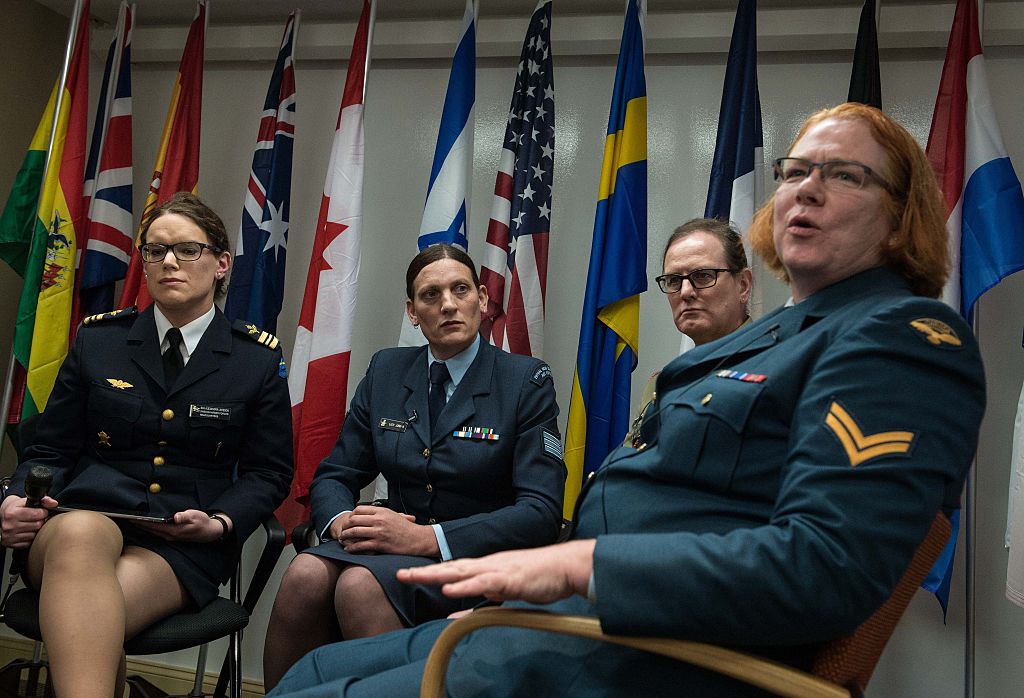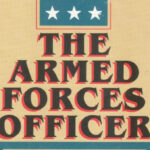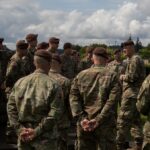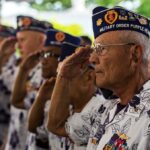
There remain deep and lingering anxieties about diversity… Military and civilian leaders should confront this cultural pathology head on.
In April 2017, U.S. Army War College faculty and students attended a mandatory training session on the recent Department of Defense policy regarding open service by transgender people. I watched an auditorium full of students and faculty squirm their way through it. The discomfort in the room was palpable, and no better at the end than at the beginning. I left feeling that the 45-minute training might have done more harm than good.
The open integration of transgender personnel is controversial. But as policy revisions go, it’s well-crafted and sensible, and has significant resources for commanders and service members, even though there will be many details to work out. Although rolled out sooner than anticipated, it is designed to maximize fairness and respect, and to minimize turmoil and churn within units. Importantly, the policy is sensitive to the diverse needs and perspectives of individual soldiers, units, commanders, medical professionals, and to the military mission.
But the policy isn’t the problem. It’s not really even the topic of this essay.
Rather, the training and the audience’s responses to it were symptomatic of two deeper concerns about how the U.S. military confronts socio-cultural issues and about how its institutions train and educate leaders about them. This training, and responses to it, made plain that there remain deep and lingering anxieties about diversity in general, and specifically about the role of women in uniform. Military and civilian leaders should confront this cultural pathology head on. However, doing so will be difficult. The training also illustrated a consistent failure to develop an appropriate working vocabulary and knowledge to engage in such discussion. This deficiency is amplified in an educational setting by the inability to merge the requirements of training into a viable educational construct. Together, these failures result in countless lost opportunities to educate and engage military officers in thinking about issues of broad social, cultural, and political significance.
The new transgender policy lives at the nexus of gender, sex, and sexuality. In the current political and cultural moment, these particularly salient topics have always prompted some anxiety and insecurity about sexual identity, experience, and normative behaviors, especially among young recruits.
The military remains (in popular and professional discourse, at least) a highly masculine space. Women, until very recently, have been categorically excluded from certain jobs and assignments, and this change has met with significant debate, opposition, and even open hostility from serving and retired service members. One needs to look only as far as the Marines United scandal or to the data on sexual harassment and assault to understand that the military has yet to make peace with the idea and reality of women’s service.
Policies about women in combat and open transgender service fundamentally disrupt the military’s binary treatment of gender and challenge deeply-entrenched values about masculinity, femininity, and gender roles within the service. Discussions about physical fitness standards, uniform requirements, grooming and appearance, maternity leave, breastfeeding, and which jobs women could (and should) fill have taken place for most of the 20th century and continue today. Policies regarding sexual orientation have likewise proved challenging, but while the military underwent significant change with the repeal of its “Don’t Ask, Don’t Tell” policy, these changes did not challenge binary conceptions of sex and gender, even though conservative opponents were concerned it would degrade military masculinity.
Most of the questions asked in this training involved male-to-female transitions or pregnancy, which is typically associated with women. The association of women with reduced readiness was borne out in the questions: could a male soldier claim to be transgender in order to qualify for lower physical standards? Could a transman get pregnant to avoid deployment? Won’t soldiers transitioning from male to female lower readiness?
The underlying assumption in all of these questions is that women fundamentally degrade military effectiveness. Digging more deeply into the sources, validity, and consequences of these assumptions and arguments will further the discussion about the experiences, contributions, and expectations of not only transgender people but also of cis-gendered women in the military.
Furthermore, these sorts of questions reflect a misunderstanding about the “ease” with which a currently-serving soldier might be able to transition to a new gender status. The policy requires: diagnosis of gender dysphoria by a military medical practitioner; a treatment plan signed off on by the soldier, a military medical provider, and the commander; a period of transition, during which the service member, medical team, and commander work to sort out issues related to timing and exceptions to policy; the changing of legal documents such as a birth certificate and passport; and finally, a switch in the Defense Enrollment Eligibility Reporting System. This long and complex process, involving some of the most intimate details of a person’s identity, opens up a number of vulnerabilities for transgender service members. Concerns that soldiers will claim to be transgender to make their lives easier seem misplaced, especially among senior leaders.
The questions and comments further suggested that trainees lacked the foundational knowledge required to facilitate serious discussion about contemporary social and cultural issues. Even if the military were fully committed to engaging in such conversations, many of its people are unprepared for discussions about gender, sexuality, race, ethnicity, socioeconomic status, religion, mental health, and disability. Instead, we rely almost solely on anecdote, personal experience, emotion, and gut feelings to guide discussions about complicated matters. Training glosses over foundational definitions and knowledge in order to move directly to discussions of policy.
This is absurd. It would be tantamount to conducting live fire training on a weapons system without appropriate familiarization and simulation first, or sending a pilot trainee up in an aircraft without sufficient academic instruction in physics, flight line operation, or aviation regulations. Yet with regard to social and cultural matters, we too often expect leaders of diverse organizations to lead with a woefully inadequate intellectual toolkit. In order to have the difficult and important discussions about the recruitment, composition, training, effectiveness, and mission of the 21st century military, our senior leaders must have a working knowledge of contemporary American society.
Imagine a world in which training on a new policy was scaffolded with a common, professional vocabulary and a foundation of facts and evidence drawn from relevant scientific, medical, psychological, and social-scientific literature — even if, or perhaps especially if, that body of literature is contested. On this issue, as with many others, there’s no consensus within scientific, psychological, or sociological communities, and standards of medical care for transgender people continue to evolve. This variance accurately reflects the way knowledge is developed and deployed in the real world, but it does not absolve institutions of delaying action until everything is “settled.”
But at an even more basic level, if we are going to talk about implementing a policy regarding transgender military personnel, let’s first make sure everyone knows what “transwoman” signifies. What if, before we started talking about pregnant transmen, sex reassignment surgery, or hormone therapy (which may not be medically required), we spent a few minutes considering the difference between biological sex, social gender, and sexual orientation? What if this training included a refresher in biology and the incredible complexity of sex differentiation in human beings? What if we looked at the diagnostic criteria for gender dysphoria or at the literature that provides estimates about the number of transgender or intersex individuals globally and within the military?
In one sense, this is extraordinarily difficult to imagine — it’s so very different from most of the training we encounter in the Department of Defense. But it would not be impossible. It would, however, require more time and engagement with civilian communities and experts, deeper use of historical examples, and the possibility of delivering more targeted training materials to different audiences.
In the midst of teaching about international relations, Clausewitz, decision-making models, the elements of national power, operational design, senior leadership, the budget process, and the importance of understanding culture (for other places, of course), and being sensitive to local needs — we are neglecting to educate our senior military officers about the socio-cultural and political ideas and forces that shape the United States and its military in the 21st century. If one of the great strategic dictums is to “know yourself, and know your enemy,” then we are failing spectacularly at the first.
One needs to look only as far as the Marines United scandal or to the data on sexual harassment and assault to understand that the military has yet to make peace with the idea and reality of women’s service.
When professional military education fails to encourage study and discussion about social, cultural, and political issues related to gender, ethnicity, generational change, disability, religion, sexual orientation, and socioeconomic status, we fail to prepare students for senior leadership in a diverse force. The joint, interagency, intergovernmental, and multinational environment is diverse. The U.S. military is already a diverse team of people — comprising males and females (cis- and trans- gendered); urban and rural; immigrant and native-born; straight and bisexual; gay and lesbian; believers and atheists — all at work together. That’s the simple reality of America in the 21st century; it’s the reality of our all-volunteer force and of our international coalitions. Leaders will be more effective if they engage with diversity rather than ignoring it, or trying to blend it away so that only Army green or Air Force blue matter.
The senior service schools and the service academies are particularly well-situated for this task. West Point has made significant strides in adding a “gender and sexuality” thread to its core curriculum, ensuring cadets receive important inter-disciplinary education in such matters. Because if these conversations don’t happen in these classrooms — in space set aside, temporally and physically, for students and faculty members to engage in rigorous analysis and critical debate on issues of vital national importance — then where will they happen? They must start early in an officer’s’ career and continue through his or her senior-level professional military education.
We should be talking about the role unit cohesion might play in enhancing or degrading effectiveness. We should talk about how physical training standards are set, evaluated, and understood, and why, for example, gender-norming elicits significant consternation but age-norming does not. We should talk about how diversity affects team performance. We should talk about uniforms and teamwork representation, and leadership. We should talk about why women and minorities remain chronically underrepresented in the highest ranks of the military. We should talk about what reasonable accommodations for religious practice look like. All of these are critically important conversations, about which a variety of viewpoints exists. But we can’t do this kind of serious talking without the vocabulary and commitment to education that it demands.
To put it bluntly, what if we demanded the same rigorous, analytical thinking about social, cultural, and political topics that we demand students apply to complex scenarios for advising on a military strategy, understanding a regional crisis, or recommending a course of action for a budget exercise?
How we define diversity and how policies are implemented to support it are important questions for discussion, and there’s certainly disagreement among military professionals and academics. There remain, for example, real questions about the physical and mental attributes required for success in combat. There are significant cultural and policy issues to be worked out about the best way to handle cases of harassment, sexual assault, and rape. There is further room for discussion about military effectiveness — both about what it means and about how best to achieve it in the 21st century.
But few people in the room seemed ready to have those conversations. And that’s what’s so concerning here — putting the merits of the policy aside for a moment—we have senior military officers who cannot, in a meaningful sense, engage in the conversation because they lack the tools to do so.
These discussions are vitally important. We ought to demand that our officers and senior leaders be well-prepared for them. But it goes beyond a liberal-academic concern for diversity and inclusion — leading diverse groups and interacting with new ideas are key skills that military leaders must develop, even during wartime. It’s not a tradeoff. It’s a necessity.
Jacqueline E. Whitt is Associate Professor of Strategy at the U.S. Army War College. The views in this article are the author’s and do not necessarily reflect those of the U.S. Army or U.S. Government.
Photo: Transgender military personnel from Sweden, New Zealand and Australia listen to Corporal Natalie Murray of Canada. Photo Credit: NICHOLAS KAMM/AFP/Getty Images





Jacqueline,
I find this article a bit disturbing, and I will articulate my concerns. As a resident student I didn’t ask any questions during this forum, but did attend the training session used as the basis for your article.
First, the training session was advertised as a “non-attribution / safe-space” for future Brigade Commanders and senior military leaders to openly discuss any questions they had on the topic with experts from legal, admin, and other areas. My question to you is whether it is a wise precedent to publicly criticize the audience about their closed-door training session, and will this type of precedent keep future senior leaders from asking questions and attempting to gain the essence of training events in the future?
While I agree that 2-3 personnel (of over 300 in attendance) may have asked questions that bordered on the immature (using your words). However, in almost all other cases I saw something completely different. What I witnessed was a group of highly professional military leaders, both men and women, attempting to wrap their heads around and understand where the army policy is on this topic. Questions on the transition process, commanders responsibility, shower facilities, urinalysis, PT standards, grooming/appearance, uniform standards, and the rights of other Soldiers in the same unit may seem “hostile” or “immature” to you. However, these are the exact real-world situations that these military leaders will facing in a few days as they depart to take commands all over the world. The training itself was advertised to assist these future commanders in the Army policy.
You “may” be correct that the military has a ways to go in understanding the full benefits of diversity, as well as changing policy on other social issues. However, I’m not sure public criticism of their questions and attempt to learn does anything but set the process back, and keep our officers from feeling that they can ask experts for help with their questions.
Finally, you reference specific questions where an audience member argued that Soldiers would “transition” to get out of deployments or get reduced PT standards. While I agree that those specific comments were immature and potentially out of line, I think it is important to note that those comments all came from the same US Army War College Faculty Instructor, not the students of the class.
There are a number of problems with this article and unsupported assertions.
You assert that gender, sex, and sexuality have “always prompted some anxiety and insecurity about sexual identity, experience, and normative behaviors, especially among young recruits” but your reference is a WWII history. Meanwhile, younger generations have proven particularly accepting and adaptable when it comes to these issues.
You argue that we should be discussing these issues in the context of “unit cohesion” without addressing that the notion was widely debunked in the fight for repeal of “Don’t Ask, Don’t Tell.” There is a dramatic difference between social cohesion and task cohesion – the latter being instrumental in accomplishing the mission. We know that diverse groups with a common mission are better at complex tasks, even without high social cohesion.
Finally, the terms “trans-gendered” and “cis-gendered” are incorrect, which you would have found had you bothered to consult, well, ANY decent usage guide. The correct terms are transgender and cisgender.
This is sloppily put together. There are indeed areas regarding gender and gender identity that are worth a thoughtful discussion, and in my experience, senior officers are engaging in those conversations with a willingness to learn. This piece contributes nothing to that conversation.
” Transgender military personnel from Sweden, New Zealand and Australia listen to Corporal Natalie Murray of Canada. ”
I’m beginning to think that the US may truly be exceptional here. Still not fully ready to accept races other than white, even after 60 years. Seriously uptight about anything to do with sex.
Do we do what was done by Truman in the 50s regarding desegregation, and what was done recently with the repeal of DADT, force many in the military to shut up and soldier, because the facts don’t support their peculiar institutional views? Or do we draw a line here, after having been so cruel before, and cater to irrationality just this once so as not to discomfit what may even be a majority of serving personnel?
Politically, there’s already a strong backlash in the GOP, with demands for immediate separation of all known trans service people. So far on administrative grounds rather than medical ones, but the FRC is demanding that all discharges be other than honorable, and all trans veterans be retroactively treated likewise,and forced to repay any benefits they’ve taken.
The degree of Animus towards trans people in the more conservative sections of society that provide much of the US military may have been grossly underestimated.
I will say only this – the ONLY thing we need to spending time on is how we can enhance force lethality and mobility. Social experiments and the clear misuse of the word “gender” can remain anywhere else.
It is time to remove all females from the military as well as sexual deviates. They have ruined the moral,physical,and mental standards as well as ruining the warrior mindset.